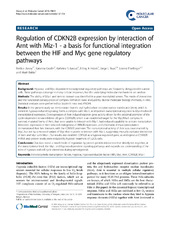| dc.contributor.author | Æsøy, Reidun | en_US |
| dc.contributor.author | Gradin, Katarina | en_US |
| dc.contributor.author | Åsrud, Kathrine Sivertsen | en_US |
| dc.contributor.author | Høivik, Erling Andre | en_US |
| dc.contributor.author | Ruas, Jorge L. | en_US |
| dc.contributor.author | Poellinger, Lorenz | en_US |
| dc.contributor.author | Bakke, Marit | en_US |
| dc.date.accessioned | 2014-09-23T13:54:59Z | |
| dc.date.available | 2014-09-23T13:54:59Z | |
| dc.date.issued | 2014-03-11 | eng |
| dc.identifier.issn | 1476-4598 | |
| dc.identifier.uri | https://hdl.handle.net/1956/8534 | |
| dc.description.abstract | Background: Hypoxia- and Myc-dependent transcriptional regulatory pathways are frequently deregulated in cancer cells. These pathways converge in many cellular responses, but the underlying molecular mechanisms are unclear. Methods: The ability of Miz-1 and Arnt to interact was identified in a yeast two-hybrid screen. The mode of interaction and the functional consequences of complex formation were analyzed by diverse molecular biology methods, in vitro. Statistical analyses were performed by Student’s t-test and ANOVA. Results: In the present study we demonstrate that the aryl hydrocarbon receptor nuclear translocator (Arnt), which is central in hypoxia-induced signaling, forms a complex with Miz-1, an important transcriptional regulator in Myc-mediated transcriptional repression. Overexpression of Arnt induced reporter gene activity driven by the proximal promoter of the cyclin-dependent kinase inhibitor 2B gene (CDKN2B), which is an established target for the Myc/Miz-1 complex. In contrast, mutated forms of Arnt, that were unable to interact with Miz-1, had reduced capability to activate transcription. Moreover, repression of Arnt reduced endogenous CDKN2B expression, and chromatin immunoprecipitation demonstrated that Arnt interacts with the CDKN2B promoter. The transcriptional activity of Arnt was counteracted by Myc, but not by a mutated variant of Myc that is unable to interact with Miz-1, suggesting mutually exclusive interaction of Arnt and Myc with Miz-1. Our results also establish CDKN2B as a hypoxia regulated gene, as endogenous CDKN2B mRNA and protein levels were reduced by hypoxic treatment of U2OS cells. Conclusions: Our data reveal a novel mode of regulation by protein-protein interaction that directly ties together, at the transcriptional level, the Myc- and hypoxia-dependent signaling pathways and expands our understanding of the roles of hypoxia and cell cycle alterations during tumorigenesis. | en_US |
| dc.language.iso | eng | eng |
| dc.publisher | BioMed Central | eng |
| dc.rights | Attribution CC BY | eng |
| dc.rights.uri | http://creativecommons.org/licenses/by/2.0 | eng |
| dc.subject | Helix-loop-helix transcription factors | eng |
| dc.subject | Hypoxia | eng |
| dc.subject | Hypoxia-inducible factor (HIF) | eng |
| dc.subject | Myc | eng |
| dc.subject | Arnt | eng |
| dc.subject | CDKN2B | eng |
| dc.subject | Miz-1 | eng |
| dc.title | Regulation of CDKN2B expression by interaction of Arnt with Miz-1 - a basis for functional integration between the HIF and Myc gene regulatory pathways | en_US |
| dc.type | Peer reviewed | |
| dc.type | Journal article | |
| dc.date.updated | 2014-04-13T08:09:08Z | |
| dc.description.version | publishedVersion | en_US |
| dc.rights.holder | Copyright 2014 Aesoy et al.; licensee BioMed Central Ltd. | |
| dc.rights.holder | Reidun Aesoy et al.; licensee BioMed Central Ltd. | |
| dc.source.articlenumber | 54 | |
| dc.identifier.doi | https://doi.org/10.1186/1476-4598-13-54 | |
| dc.identifier.cristin | 1158809 | |
| dc.source.journal | Molecular Cancer | |
| dc.source.40 | 13 | |

